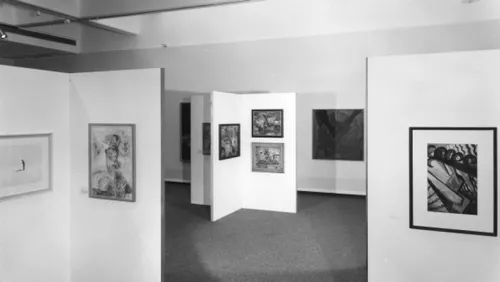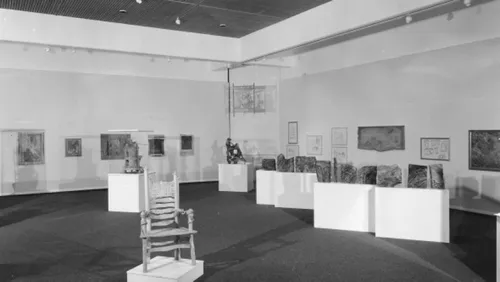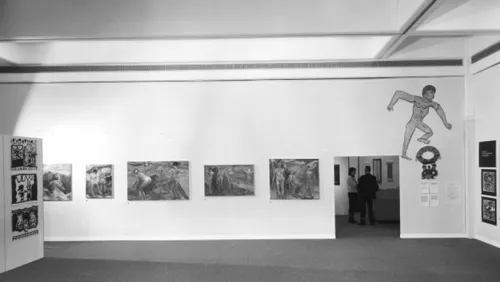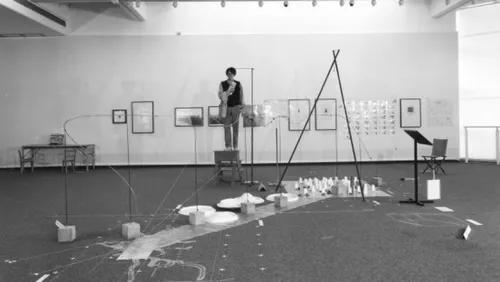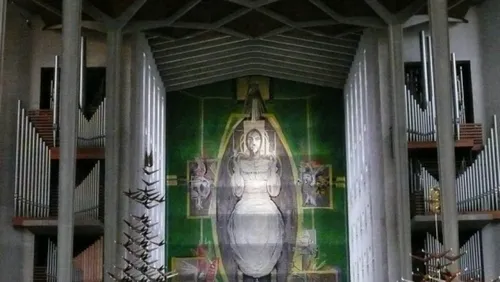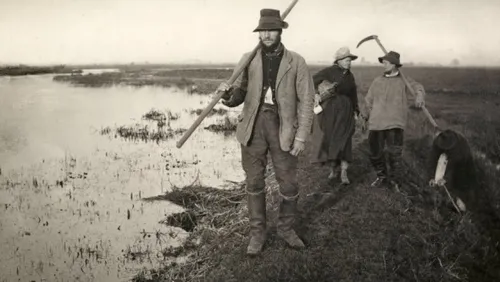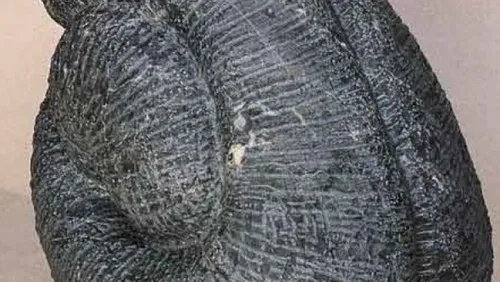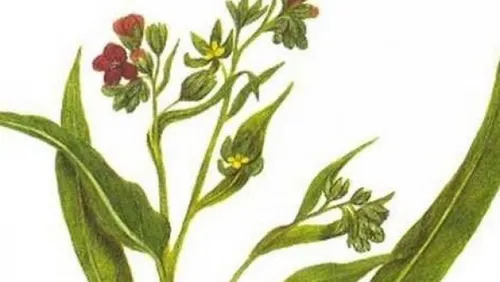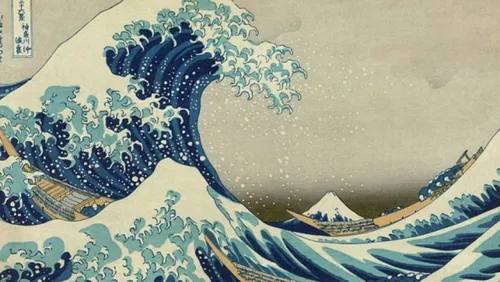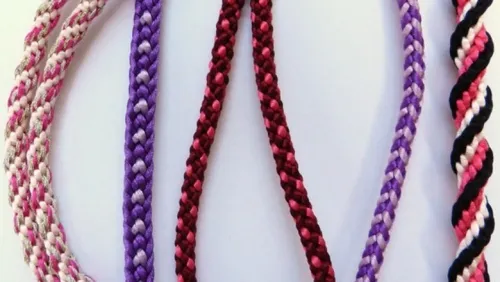Mead Gallery Exhibitions 1987
Fifty Years of British Art: the Rugby Collection
Curated and organised by Mead Gallery
Sat 14 Nov 1987 – Sat 12 Mar 1988
“This remarkable collection of 130 paintings, drawings and prints is an object lesson in how a small local authority can, with very limited funds, build up an art collection that is good to look at and full of enjoyable and sparky works.” Arts Review
David West: Castles in the Air
Touring exhibition from Exeter City Museums
Sat 14 Nov – Sat 12 Dec 1987
David West has made a series of delightful and extraordinary carvings in wood. These may be dolls’ houses or small buildings, mirrors, cupboards, picture frames or pieces of furniture. Most of this work has been commissioned and much of it makes strong reference to the particular circumstances of the client. Many incorporate ingenious devices and contain a great wealth of fascinating and intriguing detail.
Artists in Warwickshire Schools
Curated and organised by Mead Gallery
Sat 14 Nov – Sat 12 Dec 1987
Artists-in-residence have been a way to promote awareness of the work of living artists. This exhibition shows the work of some of the artists-in-residence in Warwickshire schools over the past year. The locations range from Alcester to Warwick and the different media include paint, paper, ceramic and wood.
Midland View IV: Sculpture Show
On the Town: Dick Whall
Organised by Coventry Whitefriars Sculpture Gallery.
Sat 3 Oct – Sat 31 Oct 1987
‘On the Town’ is a major, city wide sculpture exhibition. The Mead Gallery houses a section of Dick Whall’s ‘L’Appareil Pedagogique avec ses Apanages’ or ‘The Engima Machine together with its Bombs’ which embraces the Triangulation Pillar Sculpture situated next to the Mead Gallery.
Beyond Image - The Boyle Family: Earth Sculptures
Touring exhibition from the Arts Council of Great Britain
Sat 3 Oct – Sat 7 Nov 1987
The Boyle Family display a group of new works which represent the latest discoveries in a unique journey of enquiry.
Their destinations are selected at random by darts thrown blind at a map, but nothing is arbitrary or accidental in the complex studies undertaken at each site. With an almost scientific concern for accuracy, sections of the earth’s surface – natural or fabricated – are reconstructed on a fibre glass base. These facsimiles of the real world are provokingly ambivalent, Deprived of physical context by the gallery, the colour, texture, rhythm and form of our environment are recreated; the image before us is both abstract and astonishingly real.
To Build A Cathedral
Coventry Cathedral 1945-62
25 May – 20 June 1987
This exhibition brings together for the first time the original work of those involved in the design of Coventry Cathedral and its furnishings.
Following the ruin of the fourteenth century cathedral church of St Michael’s during the air raid on Coventry of 14 November 1940, the city commissioned a new cathedral. The exhibition charts this undertaking, from the rejected designs of Giles Gilbert Scott to the architectural commission eventually won by Basil Spence and the commission of the tapestry, the windows, sculptures, vases, candlesticks, lectern and vestments from artists including Ralph Beyer, Geoffrey Clarke, Hans Coper, Jacob Epstein, Einar Forseth, Elisabeth Frink, John Hutton, Lawrence Lee, John Piper, Graham Sutherland and Margaret Traherne.
The exhibition was curated by Louise Campbell of the University of Warwick History of Art department who has researched the work of Sir Basil Spence and by Katharine Eustace, Curator of the Mead Gallery.
P.H. Emerson: Photography, Life and Landscape
Toured by the Sainsbury Centre for Visual Arts, University of East Anglia
Sat 21 Feb – Sat 21 Mar 1987
The Victorian photographer and naturalist, PH Emerson, captured images of life and work in East Anglia between 1885 and 1900. “Not the least interesting aspect of the exhibition is the evident cross-fertilisation between painters and photographers which can be seen to have occurred in the latter years of the 19th century.” The Spectator.
Revelation for the Hands
Organised and toured by the Henry Moore Centre for the Study of Sculpture
20 Apr – 16 May 1987
This exhibition invites its audience to touch the twenty sculptures on show which have been selected for their tactile as well as their visual qualities. It includes works by Eric Bainbridge, Reg Butler, Stephen Cox, Jacob Epstein, Barry Flanagan, Henri Gaudier-Brzeska, Antony Gormley, Barbara Hepworth, FE McWilliam, Henry Moore, Eduardo Paolozzi, Roland Piche, Peter Randall-Page, Julian Schwarz, John Skelton, Keir Smith.
The exhibition’s curator, Adam White, Research Assistant at The Henry Moore Centre for the Study of Sculpture writes,
About the year 1917 the Romanian sculptor Constantin Brancusi exhibited a marble carving in a bag with two sleeves through which it could be felt but not seen. He meant it he said, as a ‘revelation for the hands’ Brancusi believed that sculpture must be ‘lovely to touch, not only well made’ and by this new method of display her forced the public to explore form and surface in a manner familiar to blind people but all too often neglected by the sighted. The purpose of this exhibition is to encourage that same exploration.
The artists represented here include three of the great pioneers of modern sculpture in Britain: Henry Moore, Henri Gaudier-Brzeska and Barbara Hepworth. Gaudier Brzeska’s career was tragically cut short by the First World War but during the short period which he spent in England from 1911 to 1915 he worked with ferocious energy to create a kind of sculpture which was only beginning to be seen in this country: rougher, more vigorous, anti-classical and influenced by non-European art. His statement that ‘sculptural ability is the defining of masses by planes’ set out a new aesthetic which he applied to portraiture with startling results.
Gaudier had a passion for carving which was highly unusual at the time but came to be shared by Moore and Hepworth, whose relish for the art during the 1920s stemmed partly from a belief that the sculpture must be responsive to the qualities of natural materials. The sensitivity to wood and stone which was stimulated by this approach can still be seen in Hepworth’s later carvings while Moore maintained the search for bold, simple and expressive forms which the dogma had helped him to create.
One of Moore’s formative experiences as an artist was rubbing his mother’s back when a boy and there is a note in his 1926 Sketchbook which reads, SHAPE/BY/FEEL/TOUCH opposite a drawing of a female figure. He remained convinced that tactile experience was important in sculpture and during the 1950s, when he worked mainly in bronze; he sought new means of enlivening hiss surface textures. One of these was to press common objects such as screws, the claw of a shellfish or the blade of a rasp in to a model before it was cast. The same technique was applied by FE McWilliam to express ideas of an entirely different kind derive from Irish antiquities.
The continuing allure of the ‘found object’ can be seen the work of Antony Gormley, whose ‘Touchstone’ retains the shape of a big pebble from which it was carved but enriches it with human ideas and associations. Keir Smith’s carved railway sleepers belong to the same tradition but they had suffered years of human exploitation before he stated work on them and they take as their theme a landscape which has received similar hard wear. The use of everyday things, natural and man-made, as part of larger works of art has appealed to Eduardo Paolozzi and Roland Piche.
Following this exhibition, works by Keir Smith and Peter Randall-Page were acquired for the University of Warwick Art Collection.
The Frampton Flora
Organised by Bristol City Art Gallery
Sat 21 Feb – Sat 21 Mar 1987
In 1837, a group of women – members of the Clifford Family of Frampton on Severn – began to make and collect original paintings of the wild flowers of the parish. This portraits make up the Frampton Flora. In an age which put such a high premium on individual enterprise and female orthodoxy, the paintings demonstrate a remarkable combination of collective effort and personal talent. The paintings were rediscovered in 1982 in the attic of the family home. They are also published in facsimile in a book with text by Richard Mabey.
The Japanese Eye
Touring exhibition from the Northern Centre for Contemporary Art, Sunderland
Mon 12 Jan – Sat 14 Feb 1987
Sponsored by the Japan Foundation. This exhibition of woodblock colour prints from the 18th, 19th and 20th centuries includes works by Hokusai, Utamaro, Kumisada and Yoshitoshi. They illustrate the radical changes which Japan has undergone to transform itself from a feudal empire to an industrial power.
Japanese Woodblock Prints
Touring exhibition from Roger Strange in association with the Japanese Gallery
Mon 12 Jan – Sat 14 Feb 1987
Japanese Woodblock Prints are the most popular form of Far Eastern art to reach the western world. They first arrived in Europe after the opening of Japan to foreign trade in the 1860s and were seized upon by artists such as Manet, Degas, Van Gogh and Toulouse Lautrec. The exhibition includes a selection of antique prints dating from the 18th century to the present day, a variety of traditional clothes in silk and cotton and handmade wood and paper lamps.
Kumihimo
Touring exhibition from Stafford Art Gallery
Mon 12 Jan – Sat 14 Feb 1987
Kumihimo is the term for a range of techniques that have been used in Japan for many centuries to produce a rich variety of braids. This is the first exhibition on the subject in this country and has three sections: tradition, techniques and innovation. Each section is illustrated with framed examples of braids and photographs. The techniques are also illustrated with four different Japanese looms and a selection of natural dye materials.
The innovation section shows the application of the braiding technique in neckpieces by Catherine Martin, silver-wire jewellery by Rachel Leach and hats by Anne Tomlin.

